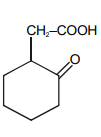Select the correct option based on statements below:
Assertion (A):
Benzaldehyde undergoes a condensation reaction when heated in the presence of KCN.
Reason (R):
Benzaldehyde has no α- H atom.
1.
Both (A) and (R) are true and (R) is the correct explanation of (A).
2.
Both (A) and (R) are true but (R) is not the correct explanation of (A).
3.
(A) is true but (R) is false.
4.
Both (A) and (R) are false.
Select the correct option based on statements below:
| Assertion (A): | The addition of ammonia derivatives to carbonyl compounds is carried out in a weakly acidic medium. |
| Reason (R): | In a weakly acidic medium, the attacking nucleophile is also protonated. |
| 1. | Both (A) and (R) are true and (R) is the correct explanation of (A). |
| 2. | Both (A) and (R) are true but (R) is not the correct explanation of (A). |
| 3. | (A) is true but (R) is false. |
| 4. | Both (A) and (R) are false. |
Consider the given two statements:
| Assertion (A): | Aldehydes are more reactive than ketones in nucleophilic addition reactions. |
| Reason (R): | The magnitude of the positive charge present on the carbonyl carbon of aldehydes is greater than that of ketones. |
| 1. | Both (A) and (R) are True and (R) is the correct explanation of (A). |
| 2. | Both (A) and (R) are True but (R) is not the correct explanation of (A). |
| 3. | (A) is True but (R) is False. |
| 4. | Both (A) and (R) are False. |
Select the correct option based on statements below:
| Assertion (A): | Esterification of carboxylic acids with alcohol is a nucleophilic acyl substitution. |
| Reason (R): | Both the C-O bond lengths in HCOO- are equal. |
| 1. | Both (A) and (R) are True and (R) is the correct explanation of (A). |
| 2. | Both (A) and (R) are True but (R) is not the correct explanation of (A). |
| 3. | (A) is True but (R) is False. |
| 4. | Both (A) and (R) are False. |
Select the structure of chromium complex formed. When the toluene reacts with chromyl chloride to give benzaldehyde on hydrolysis :
1. 
2. 
3. 
4. 
The product 'B' in the below mentioned reaction is:
\(CH_3 C \equiv N + H_2O \xrightarrow[\text{Excess}]{H^+}\ A\ \xrightarrow[\Delta]{NaOH\ +\ CaO}\ B\)
1.
2.
3.
4.
The reagent A in the below mentioned reaction is:
1. (i) LiAlH4; (ii) H2O
2. H2/Ni
3. (i) NaBH4; (ii) H2O
4. Zn-Hg/HCl
Which of the following is maximum reactive for decarboxylation :-
1. 
2. 
3. 
4. 
Select the correct option based on the statements below:
| Assertion (A): | 2,2-Dimethylpropanal also shows Cannizzaro reaction. |
| Reason (R): | It contains a sterically hindered α -H atom. |
| 1. | Both (A) and (R) are true and (R) is the correct explanation of (A). |
| 2. | Both (A) and (R) are true but (R) is not the correct explanation of (A). |
| 3. | (A) is true but (R) is false. |
| 4. | Both (A) and (R) are false. |
Select the correct option based on statements below:
| Assertion (A): | Acetyl chloride doesn't show a haloform reaction. |
| Reason (R): | Acetyl chloride has no α-Hydrogen. |
| 1. | Both (A) and (R) are true and (R) is the correct explanation of (A). |
| 2. | Both (A) and (R) are true but (R) is not the correct explanation of (A). |
| 3. | (A) is true but (R) is false. |
| 4. | Both (A) and (R) are false. |







